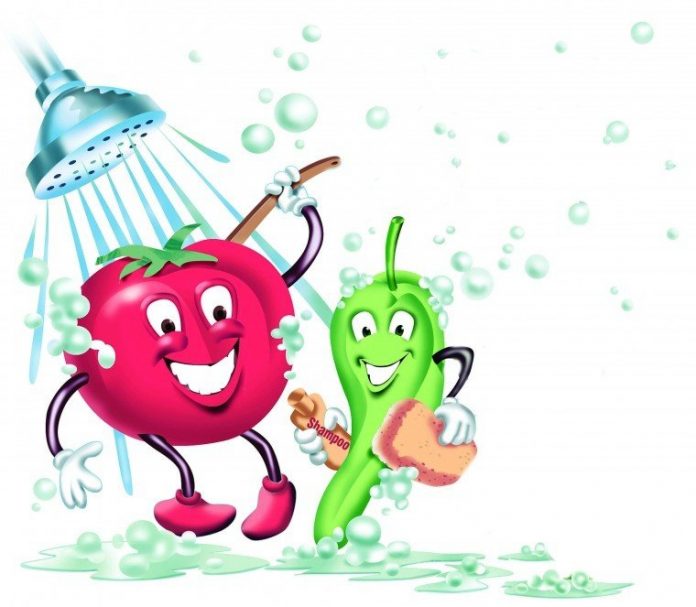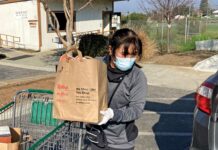If you follow the news about foodborne illnesses, you might
wonder about the safety of our meats, fruits and vegetables.
If you follow the news about foodborne illnesses, you might wonder about the safety of our meats, fruits and vegetables.
There’s good news and bad news. First, the bad: About 76 million cases of foodborne illnesses occur each year in the United States, according to the Centers for Disease Control and Prevention. Taken together, foodborne illnesses result in 325,000 hospitalizations and 5,000 deaths yearly.
Here’s the good news: The majority of cases are mild, according to the CDC. Also, improper food handling causes many cases of foodborne illness. That means you can take steps to protect yourself, says Molly Hudson, a food-safety instructor in the Institute of Technology’s culinary program in Clovis, Calif.
To minimize your chances of falling ill, we’ve collected food-safety tips used in commercial kitchens.
Remove accessories
Don’t wear jewelry or fake nails while cooking. Remove all rings, bracelets and wristwatches. They can harbor bacteria and contaminate food, says Bruce Staebler, a certified executive chef and former head of the kitchen at Saint Agnes Medical Center in Fresno. As for fake nails, they can fall into food, he says.
Wash hands
Wash your hands often and properly. Wash them before preparing or serving food, and after touching raw meat, poultry, seafood and produce, Staebler says.
When washing hands, rub soap into them for 15 seconds before rinsing off, Hudson says. Washing your hands for that long “will kill the bacteria,” she adds. “If you shorten that time frame, it only makes the bacteria stronger.” Also, if you wash your hands according to these guidelines, anti-bacterial soap is not necessary, she says.
Wash produce, not meats
Wash your fruits and veggies, but not your meats. The CDC recommends washing all produce under running water before prepping or eating. Use a brush to scrub off any stubborn dirt, Staebler says.
Keep the running water at about the same temperature as the produce, Hudson says. “Any severe change in temperature opens up the skin (of fruits and vegetables) and allows the bacteria to absorb into the skin.”
By contrast, Hudson doesn’t recommend washing meat, especially chicken. “With chicken, there’s a lot of salmonella,” she says. “People rinse their chicken and they contaminate their sinks. All you’re doing is spreading the salmonella around your kitchen.” If you cook meat to proper internal temperatures, the heat will kill salmonella that may have been on the surface.
Check the Temperature
Cook all types of poultry to 165 degrees. “Combination foods,” such as frozen lasagna and other prepared dishes to be reheated, also should reach 165 degrees for 15 seconds, she says. All types of ground meat (excluding poultry) need to reach 155 degrees. And cook seafood, steaks, pork chops and eggs (poached, scrambled or fried) to 145 degrees.
Sanitize
Clean and sanitize. Here’s a typical scenario: A home cook slices poultry or meat on a cutting board, transfers the meat to a plate, then washes the board with soap, water and a sponge before using it to chop vegetables. Does this prevent the spread of bacteria?
No. The sponge cleaned the cutting board but didn’t sanitize it.
There’s a difference between cleaning and sanitizing, says Don Waddell, the culinary division director at the Institute of Technology in Clovis. “Cleaning means wiping off visible debris,” he says. “Sanitizing reaches the microscopic level.”
Sanitizers include Clorox Anywhere Hard Surface daily sanitizing spray or Lysol Food Surface Sanitizer. Neither is appropriate for wooden cutting boards, but plastic ones are OK.
Follow this method of preparing food if you have only one cutting board: Slice bread on the board, and transfer to a plate. Then cut cleaned fruits and vegetables on the board, and set them aside on a plate. Wash the cutting board, knives and sink with hot soap and water, spray with sanitizer and let them air dry. If raw produce touched the counter, clean and sanitize that as well. Then cut all of your meats and seafood, set them aside on a plate, and clean and sanitize everything again.
All of this cleaning in the middle of food prep can get unwieldy when you’re pressed for time. It’s easier to keep two cutting boards and knives for each board.
“Just remember to put protein on one cutting board, veggies on another,” Staebler says. “Then turn the veggie one over and slice bread.”
You’ll still have to wash your hands and sink (and countertops, if raw, perishable food touched them) in the middle of prep. But if you keep the cutting boards and knives separate, you can skip cleaning and sanitizing them until you’re done.
For the final cleaning, use the dishwasher to sanitize plastic cutting boards. Just be sure to run the high-heat rinse and high-heat dry cycles, Hudson says. The energy-saving settings won’t be hot enough.
Also clean and sanitize countertops after each cooking session. And don’t forget the sponges. Dampen them with water, then microwave each of them for 20-30 seconds at high heat. Zap them one at a time to prevent fires, Hudson says.
Store Safely
Keep produce meant to be eaten raw separate from other raw foods.
As for cooked food, it should be stored below 41 degrees within two hours. That’s because bacteria thrives in a “danger zone” of 135-141 degrees, Hudson says. There’s also a “rapid growth zone” for bacteria, which is 125-170 degrees.
Given this advice, you never should place a large pot of steaming food directly into the refrigerator or freezer, Staebler says. In addition to heating up the surrounding space, it won’t cool quickly enough. Instead, spread the food onto a shallow pan to help it cool faster. Refrigerate after the steam disperses.
To store the pot itself, first cool its contents to 70 degrees, Hudson says. Place the pot in a sink filled with ice water, stir its contents, check its temperature with a thermometer and refrigerate. To freeze, transfer cooled food to smaller containers. Label the containers with the date and contents, then store and eat within three to six months (or sooner, if a recipe tells you to).
Thaw Safely
Thaw frozen food in the refrigerator. But if you’re in a pinch, thaw a container under cold, running water, Staebler says. Once you’ve thawed the food, eat it within three days for optimum safety. The same goes for refrigerated leftovers.
And when serving, it’s best to discard perishable food after four hours at room temperature. If you’d like to save leftovers, then refrigerate within three hours. But if you’re serving food in hot weather, such as a picnic, then throw away all leftovers.
Use common sense. “When in doubt, throw it out,” Staebler says. “If people would just use common sense, they probably would eliminate 80 percent of foodborne illness in the home.”












